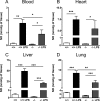Protection against endotoxic shock as a consequence of reduced nitrosative stress in MLCK210-null mice
- PMID: 17255312
- PMCID: PMC1851870
- DOI: 10.2353/ajpath.2007.060219
Protection against endotoxic shock as a consequence of reduced nitrosative stress in MLCK210-null mice
Abstract
This study investigated the consequences of deletion of the long isoform of myosin light chain kinase (MLCK210) on the cardiovascular changes induced by the bacterial endotoxin lipopolysaccharide (LPS) and cecal ligation puncture using MLCK210-/- mice. Here, we provide evidence that deletion of MLCK210 enhanced survival after intraperitoneal injection of LPS or cecal ligation puncture. LPS-induced vascular hyporeactivity to vasoconstrictor agents was completely prevented in aorta from MLCK210-/- mice. This was associated with a decreased up-regulation of nuclear facor-kappaB expression and activity, inducible nitric-oxide synthase, and level of oxidative stress in the vascular media. Furthermore, LPS-induced increase of nitric oxide production in the circulation and tissues (including heart, liver, and lung) that was correlated with an increased expression of inducible nitric-oxide synthase was also reduced in MLCK210-/- mice. These data demonstrate a role for MLCK210 in endotoxin shock injury associated with oxidative and nitrosative stresses and vascular hyporeactivity.
Figures





References
-
- Hotchkiss RS, Karl IE. The pathophysiology and treatment of sepsis. N Engl J Med. 2003;348:138–150. - PubMed
-
- Parrillo JE. Pathogenetic mechanisms of septic shock. N Engl J Med. 1993;328:1471–1478. - PubMed
-
- Dudek SM, Garcia JG. Cytoskeletal regulation of pulmonary vascular permeability. J Appl Physiol. 2001;91:1487–1500. - PubMed
-
- Yuan SY, Wu MH, Ustinova EE, Guo M, Tinsley JH, De Lanerolle P, Xu W. Myosin light chain phosphorylation in neutrophil-stimulated coronary microvascular leakage. Circ Res. 2002;90:1214–1221. - PubMed
Publication types
MeSH terms
Substances
LinkOut - more resources
Full Text Sources
Other Literature Sources
Molecular Biology Databases

